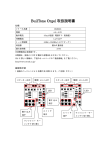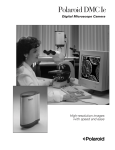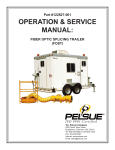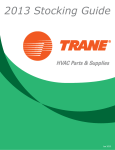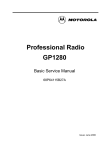Download View Acrobat Installation & Service Manual
Transcript
Installation & Service Manual for Centrifugal Mist Collectors MODELS: CM-100, CM-200 CM-300, CM-500 CM-700, CM-900 & CM-1200 January 29, 2003 TABLE OF CONTENTS Page Subject 2 ................................................. Table of Contents 3................................................. Disclaimer 4................................................. Uncrating 5................................................. Applications/General 6-7.............................................. Installation 7................................................. Figure 1 Motor Connection Diagram 8................................................. Figure 2 Parts Identification 9................................................. Parts List 10-12.......................................... Maintenance 13............................................... Troubleshooting Chart 14............................................... Add-On Prefilter Configuration 15............................................... HEPA Configuration 16............................................... Drain Kit Installation 17............................................... Warranty 2 Installation and Service Manual for Centrifugal Mist Collectors DISCLAIMER: Although instructions and recommendations are included for installation of your Centrifugal Mist Collector equipment, the manufacturer does not assume responsibility for the installation of this equipment nor shall he be held liable for direct or consequential damages resulting from improper installation, application, maintenance or use. The immense variety of contaminants make it impossible to list all of the potential hazards that may be encountered with air pollution control systems. It is therefore important that the application of the equipment be discussed with an AER Control Systems representative or application engineer prior to use. Additionally, users should consult and comply with all National and Local Fire, Electrical and /or other appropriate codes when determining the application, location and operation of any air pollution control equipment. Collection of combustible or explosive materials and collection on flame or spark-generating operations may require specific system configurations (contact AER Control Systems LLC. Applications Engineering Department for questions and/or design assistance). The combined collection of combustible or explosive materials and contaminants from spark or flame generating operations, with a common collector or duct system, is not recommended, unless special design provisions have been made to the system (sparks or flames resulting from such operations may ignite the combustible or explosive material). Under no circumstances should anyone be allowed to discard a lighted cigarette, other burning materials, or refuse into an inlet hood or the duct of the collection system. It is the responsibility of the end user to comply with all applicable national, state, and local fire and safety codes. This manual should be read completely before attempting Operation or Maintenance of this equipment. All work should be performed by qualified personnel according to local requirements. WARNING Failure to comply fully with the following instructions and local code requirements may increase your risk of physical injury due to fire, explosion or electrical shock. All data and dimensions in this manual have been thoroughly checked however, we cannot assume responsibility for possible errors or omissions. We reserve the right to change designs and/or specifications without notice. 3 Installation and Service Manual for Centrifugal Mist Collectors SECTION 1 UNCRATING 1. Remove cardboard carton banded to the wooden shipping pallet. 2. Remove the carriage bolts or lag screws securing the Centrifugal Mist Collector base to the pallet. The four Fabrica washers included with the collector should be retained for use when mounting the unit. 3. Inspect the exterior of the unit for shipping damage; contact the shipping company if any damage has occurred. 4. Remove the "V" retaining clamp ring securing the inlet cover and remove the cover. If installed, remove the cardboard spacers wedged between the casing and the rotating drum (wedges are used primarily on Models CM-700 thru CM1200). The drum should now rotate freely and the motor cooling fan should not rub on the fan guard. Replace inlet cover and secure with "V" retaining clamp ring and safety lock pin. The unit is ready for installation. 4 Installation and Service Manual for Centrifugal Mist Collectors SECTION 2 APPLICATIONS - GENERAL 1. Mist - The Centrifugal Mist Collector is intended for the collection of a variety of airborne, liquid particulate (mists). It is not a dust collector or centrifuge and should not be used to filter solid particulate from liquids. Centrifugal Mist Collectors are typically applied to applications that generate mist as the primary contaminant. airborne 2. Size It is important that the proper size unit has been selected for the application. Too little airflow will not draw the contaminant into the filter and the unit will not be completely effective. Too much airflow may result in the unit picking up large or heavy solid particles increasing the frequency of maintenance or filter replacement. Questions regarding proper unit sizing should be directed to your local AER Control Systems representative or the main office (toll free 866-2652372). 3. Add-On Prefilter - Certain applications such as grinding, particularly those with heavy metal removal rates, may result in a build-up of grinding swarf or other solid particulate. Other applications include high speed turning operations that generate large amounts of fine chips. It is strongly recommended, in these cases, that an Add-On Prefilter (available from AER Control Systems LLC.) be used to extend the maintenance cycle of the Centrifugal Mist Collector. 4. Smoke - The Centrifugal Mist Collector can be equipped with a HEPA module designed to filter mild to moderate amounts of smoke (oil smoke, smoke mixed with oil mist) or for critical efficiency applications. A high capacity HEPA module is available (CM-500 to 1200) for heavier applications or for extended run times between maintenance. 5. Gas & Vapor - The CM series collectors can also be equipped with a Gas / Vapor modules for control of these contaminants. The modules can be added with or without the HEPA module stage. 5 Installation and Service Manual for Centrifugal Mist Collectors SECTION 3 INSTALLATION 1. The unit is most often installed horizontally; however, it may also be installed in a vertical position with the inlet end down (consult factory). 2. Location of Unit - The unit should be mounted as close to the source of the mist as practical. This will keep the length of ducting to a minimum resulting in maximum available airflow. 3. Securing the Base - The mounting pedestal has four (4) 9/16" diameter mounting holes on 10" centers. Secure the base to the mounting surface with four (4) 1/2" diameter machine screws of suitable length. The four Fabrica washers included with the collector should be used as shims under the four mounting points of the cast aluminum base and especially in cases where the Centrifugal Mist Collector is to be mounted on a continuous flat surface. 4. Ducting a.) Cut the appropriate length of flexible hose. Keep the length to a minimum and keep the number of bends and turns to a minimum. Those bends which are necessary should be made as gradual as practical. b.) Attach the hose to the inlet of the unit and secure tightly with an adjustable hose clamp. Attach the opposite end of hose to the hooding or enclosure of the machine and secure with another clamp. Flange connectors are available from AER Control Systems to facilitate attachment of the hose to most hoods or enclosures. c.) The flexible hose should maintain a downward slope from the unit to prevent deposits of oil from settling at low points in the hose and to prevent liquids from washing dirt and solid particles into the collector (increased maintenance). d.) If hard ducting is used, a minimum 18" length of flex hose should be connected to inlet cover of the unit for easy removal of cover. 5 Drain Connection a.) Models CM-100 & CM-200 are equipped with a 1" N.P.T. male drain fitting while Models CM-300 through CM-1200 have a 1-1/4" N.P.T. fitting. The drain fitting is most often connected to the reservoir to eliminate the need for emptying containers. A separate, vented container may, however, be attached to the drain if desired. There is also a secondary drain fitting further to the rear of these units. This is a 1/4" N.P.T. 90° elbow fitting, and should be connected as the primary drain discussed above. 6 Installation and Service Manual for Centrifugal Mist Collectors SECTION 3 INSTALLATION (continued) b.) Either rigid pipe or a flexible hose may be used for the drain connection. It is recommended that the pipe or hose used for this connection be at least 3/4" in diameter for the CM-100 and CM-200 and 1" for the remaining models. NOTE: 1) 2) NONE OF THE DRAIN HOSE ENDS SHOULD SUBMERGED, BLOCKED OR OBSTRUCTED FOR PROPER FLUID DRAINAGE THE SECONDARY DRAIN HOSE SHOULD NEVER BE CONNECTED TO THE PRIMARY DRAIN HOSE (see Drain Kit Installation Diagram). 6. Electrical installation - Wiring diagrams can be found on the top or underside of the motor conduit box cover. (See Figure 1) Standard models may be wired for 190 or 380 volt, 50 cycle or, 230 or 460 volt, 60 cycle, three phase input power. CONNECTION DIAGRAM Circled numbers correspond to number tags on wires inside junction box. Figure 1 7 BE Installation and Service Manual for Centrifugal Mist Collectors Figure 2 8 Installation and Service Manual for Centrifugal Mist Collectors SECTION 4 PARTS LIST Listed Numerically in Order of Disassembly - See Figure 2 Item No. Part Name CM-100/200 CM-300/500 CM-700/900/1200 1 —V" Retaining Ring CM5024-01 CM5024-01 CM5024-02 2 Cover CM5011-02 CM5011-03 CM5011-01 3 —O" Ring Cover Seal CM5019-01 CM5019-01 CM5019-02 4 Nut-Motor 5 Drum Assembly (includes items 6 & 7) 6 Nut, Centerlocking 5/8-18, 02-6218HXR CM5002-01/-02 CM5002-03/-04 CM5002-05/-06/-07 1st Stage Throwaway Filter Available as a 6 pack only CM5028-01 CM5028-04 CM5028-02 CM5028-05 CM5028-07 CM5028-06 7 2nd Stage Primary Filter CM5026-01 CM5026-02 CM5026-04 8 Screw, Exhaust Grill (2 req.) 9 Exhaust Grill Assembly CM5038-01 CM5038-02 CM5038-03 10 4th Stage Exhaust Filter (includes 3 tie wraps) CM5029-01 CM5029-02 CM5029-03 11 Screw, Motor Mounting (4 req.) 12 Washer Lock (4 req.) 13 Motor (includes item 14) 14 Gasket-Motor Mounting 15 Washer Lock (3 req.) 16 —O" Ring (3 req.) 17 Screw, Hex Head (3 req.) 18 Cast Stand CM5037-02 CM5037-01 CM5037-01 19 Housing CM5010-01 CM5009-01 CM5008-01 20 3rd Stage Secondary Filter CM5027-01 CM5027-02 CM5027-03 21 Internal Screen CM5018-01 CM5018-02 CM5018-03 Screw, #8 TEK 3/4" Long, 01-06075TEK Screw, Socket Head Cap 3/8-16 UNC Thread x 3/4" 01-38075SOCP Screw, Socket Head Cap 3/8-16 UNC Thread x 1" 01-38100SOCP Washer Lock 3/8 03-38WL CM5000-05K CM5000-02K CM5000-03K CM5020-01 Washer Lock 3/8 03-38WL 9/32 ID x 9/16 OD x 1/8 Thick CM5025-01 3/8-16 UNC Thread x 1.25" Long 01-38125HX 9 Installation and Service Manual for Centrifugal Mist Collectors SECTION 5 MAINTENANCE 1. The maintenance of the Centrifugal Mist Collector is relatively simple and consists basically of replacing the 1st Stage Throwaway Filter at regular intervals. The replacement interval is a function of the degree of solid particles in the collected fluids or plant air. Where clean oil mist is being injected, the unit can easily run for a year or more without maintenance of any kind. In applications where a heavy concentration of solid particulate, such as grinding swarf is present in the coolant or dust is present in the air, monthly filter replacements may be necessary. It is highly suggested that the AddOn Prefilter be installed on applications with dirty coolant or in-plant air to extend filter life and reduce maintenance. It is recommended that when a unit is first installed the filter be checked weekly until a maintenance schedule can be established. This can be accomplished by merely removing the "V" retainer ring and front cover and visually inspecting the 1st Stage Filter when the Centrifugal Mist Collector is not operating. After each inspection, a progressive darkening of the 1st Stage Filter will be noticed. If the discoloration is uniform, or shows up as equally spaced patches (usually at each blade), the unit can be run until the filter is about 75% darkened with solids. At this point the filter should be removed and held up to a light source to determine how much of the filter is blocked with solids. To maintain system efficiency the 1st Stage Throwaway Filter should be replaced when 50% to 75% of the filter is blocked by solids or if mist appears at the outlet screen. After the first replacement, an inspection schedule should be set up so that the filter may be replaced before it becomes completely clogged and ineffective. However, if during the inspection period a heavy or non-uniform build-up of contaminant appears the filter should be immediately replaced to avoid creating an imbalance in the drum that can lead to undesirable vibration in the unit. 2. Procedure for Replacing 1st Stage Throwaway Filter CAUTION: BEFORE REMOVING THE COVER MAKE CERTAIN THAT THE POWER TO THE UNIT IS OFF AND IS LOCKED OUT AND THAT THE ROTATING DRUM HAS COMPLETELY STOPPED TURNING. a.) Take note where the ends of the 1st Stage Filter overlap. The midpoint of the overlap should be aligned with an index mark, in the form of a slot, on the front rim of the drum. b.) Remove the 1st Stage Throwaway Filter and discard. c.) Feed the replacement filter under each blade so that the ends come together at the index slot. The filter will appear to be too long, however do not trim to fit. Instead, work the material along the inner surface of the drum and overlap the filter at the index mark similar to the original filter. The seam will still be slightly raised and a few 'waves" will appear around the circumference of the filter, this is normal and the filter typically flatten or —seat" once the unit is operated. d.) Replace the cover, clamping ring and safety lock pin, turn on the power and let the unit come up to speed; then shut off power. When the drum has come to a complete stop, remove the cover and inspect. (Continued on next page) 10 Installation and Service Manual for Centrifugal Mist Collectors SECTION 5 MAINTENANCE (continued) The filter should be smoothly seated and flat. If the material does not seat properly or some wrinkles are present, hand smooth the troublesome areas and repeat as above. It is seldom necessary to repeat this step more than once. 3. 2nd Stage Primary Filter Replacement Under normal operating conditions and with scheduled 1st Stage Throwaway Filter replacement, the 2nd Stage Primary Filter (Item No. 7) will not require replacement. It is, therefore, advisable that this filter not be removed or tampered with as this may adversely affect the dynamic balance of the drum assembly. If, however, it becomes necessary to replace it because of delayed maintenance or accidental damage; the same procedure used for replacing the 1st Stage Filter should be followed however the filter is butted together at the index mark. The filter will appear too long but it must not be trimmed to fit. Butt the filter edges together and work the filter material until the seam is smoothly butted together and the filter lies flat in the drum. Due to the heavier weight of the 2nd Stage Filter, a trial and error shifting of the seam may be necessary in order to keep vibration to a minimum. If vibration continues, it may be necessary to dynamically re-balance the unit. 4. Power Flushing Filters In applications on water soluble coolants, coolant gelling or crystallization due to water evaporation can prematurely block filters in the CM collector. Because replacement of the 2nd Stage Primary Filter may affect the balance of the collector; it may be desirable to attempt flushing the filters out rather than replacing them. Due to the Mist Collector's ability to handle extremely heavy concentrations of liquids, if the collected material can be reliquified (such as water-soluble coolants); the filters can be power flushed out. In many cases a heavy coolant flush of the filters will not only eliminate the need for filter replacement, but may also remove some of the solids within the filter, resulting in reduced unit vibration. The flush procedure is as follows: Examine the 1st Stage Throwaway filter, (if loaded with solids it should be replaced) and disconnect flex hose to cover of unit. If unit is equipped with an Add-On prefilter trap, remove the trap and block off the drain line. Install cover to collector, turn on the power and let unit reach full operating rpm. The drain lines can be moved to drain into a separate container, if a liquid other than the coolant being collected is used to flush the unit in order to prevent coolant tank contamination. Pour or spray flushing liquid into the inlet of the collector, start slowly at first; eventually, as filters are flushed out, you will be able to pour or spray a few gallons at a time through the collector. After flushing, allow unit to run for a few minutes to purge remaining liquid from the drum. During the flush operation you should note a heavy liquid (may be dirty) flow out the drain lines. Do not obstruct or submerge main drain line, any back pressure on line will reduce drain system efficiency. 11 Installation and Service Manual for Centrifugal Mist Collectors Because Primary Filter blockage cannot be determined by visual inspection, it is suggested that you perform the following test to check the permeability of the primary filter and the effectiveness of the power flush procedure: Turn off unit power and allow drum to stop rotating. Remove the cover of the collector and pour one cup of the coolant that you are collecting into the drum assembly of the collector, so that it must drain through the 2nd Stage Primary Filter. Examine how quickly the coolant drains through the filter. If the coolant puddles or takes a considerable amount of time to drain, then the filter remains blocked and a second flush may be required. If the coolant drains through the filter rapidly, the flush was sufficient to clean the filter out. Simply replace the throwaway liner, prefilter (if applicable), cover and intake hose. Power flushing the unit with clean coolant (or liquid) and checking the filters periodically will determine the optimum replacement and power flush cycles. If frequent flushing is required, the unit can be equipped with a flush nozzle that is connected to a clean coolant feed line allowing you to power flush the filters in place. The 1st Stage Throwaway Filters should be replaced before they accumulate too many solids to prevent these solids from being flushed into the 2nd Stage Primary Filter. The spray wash nozzle attachment will simplify the flush procedure and reduce the time required to flush each unit. 5. 3rd Stage Secondary Filter and 4th Stage Exhaust Filter Replacement These filters (Item No. 10 & 20) seldom require replacement, but if for any reason new ones have to be installed, their replacement is extremely simple as a study of Figure 2 or examination of the actual parts will show the method of replacement. Replacement of the 3rd Stage Secondary Filter (Item No. 20) will require removal of the rotating drum. 6. Lubrication The motor is equipped with oversize bearings, which are lubricated for the life of the motor. No lubrication is required. 7. Replacement of Miscellaneous Components The rest of the components require no maintenance and need only be replaced in case of accidental damage. A review of the disassembly sequence and a study of Figure 2 will show the procedure to follow in replacing any of the damaged parts. 12 Installation and Service Manual for Centrifugal Mist Collectors TROUBLESHOOTING CHART CAUTION: BEFORE DISASSEMBLING THE UNIT, OR DOING ANY INSPECTING OF THE PARTS, MAKE CERTAIN THAT THE POWER HAS BEEN SHUT DOWN AND LOCKED OUT AND THAT THE DRUM HAS COME TO A COMPLETE STOP. NEVER RUN THE UNIT WITH THE COVER REMOVED. PROBLEM POSSIBLE CAUSE REMEDY Unit Fails to Start Dead Input Power Line(s) Tripped Motor Starter Loose or Bad Connection Failed Motor Check Input Power Reset Starter Reconnect Wires Replace Motor Unit Runs Slowly Wired for Wrong Voltage Loss of Power to One or More Input Line Obstruction Between Housing and Drum Check Input Voltage and Check Wiring Diagram Check Input Voltage on All Lines Take off Cover and Remove Obstruction Dirty 1st Stage Filter and/or Plugged 2nd Stage Filter Ultra-fine Mist (or Smoke) Replace Filter Power Flush Filter or replace Add HEPA module Mist Exhausted From Outlet of Unit Droplets Exhausted From Undersized or Reduced Main Outlet of Unit Drain Line Submerged Main Drain Line Vibration Replace with Correct Size Drain Hose Shorten Hose Length Blocked or Kinked Main Drain Line Unblock or remove Kink in Hose Loose Mounting Bolts Dirt or Foreign Object In Drum Replace Motor Bolts Replace 1st Stage Filter and/ or Remove Object Rebalance or Replace Imbalanced or Damaged Drum 13 Installation and Service Manual for Centrifugal Mist Collectors Item CM5016 CM5016- -01 Note: CM5016-01 is used on the CM100 thru the CM-500's. CM5016-02 is used on the CM700 thru the CM-1200's. Add-On Prefilter Configuration 14 P/N: Description Add-On Prefilter 02 1 1 ~ CM5016-11 2 1 ~ CM5027-06 Filter 3 1 ~ CM5052-10 Retainer 4 1 ~ CM5024-01 V-Ring 5 1 ~ CM5019-01 O-Ring 6 ~ 1 02-3118WNG Wing-Nut 7 ~ 1 CM5016-12 Add-On Prefilter 8 ~ 1 CM5027-07 Filter 9 ~ 1 CM5052-11 Retainer 10 ~ 1 CM5024-02 V-Ring 11 ~ 1 CM5019-02 O-Ring 12 6 6 1055-04 Nylon Hose 13 1 1 01-31100HX Bolt 5/16-18x1 hex 14 1 1 05-HT050N Tee 1/2x1/2x1/2 15 1 1 02-3118HX 5/16-18 Hex Nut 16 1 1 03-31WL 5/16 Lock Washer 17 2 2 03-31WF 5/16 Flat Washer Installation and Service Manual for Centrifugal Mist Collectors HEPA Configuration Item CM5003-01 CM100/200 1 1 ~ 2 ~ 3 P/N: Description ~ CM5043-10 HEPA Housing sm 1 ~ CM5039-10 HEPA Housing med ~ ~ 1 CM5040-10 HEPA Housing lrg 4 1 ~ ~ CM5048-01 Cover HEPA sm 5 ~ 1 1 CM5049-01 Cover HEPA med/lrg 6 ~ 1 1 1040-01 HEPA Filter 12x24x12 7 1 ~ ~ 1040-03 HEPA Filter 12x12x6 8 4 4 4 01-08075TEK #8 x .75 Tek Screw 9 As req'd. As req'd. As req'd. 15 CM5003-02 CM300/500 CM5003-03 CM700-1200 ~ Silicone Sealant Installation and Service Manual for Centrifugal Mist Collectors NOTES: 1.) NONE of the drain hose ends should be submerged or obstructed. 2.) Secondary drain hose should NEVER be connected to Primary drain hose. Drain Kit Installation Diagram 16 LIMITED WARRANTY AER Control Systems LLC warrants all products sold only to purchasers for use in business or for resale, against defects in workmanship or materials under normal use, for one (1) year after the date of purchase from AER Control Systems LLC. Misapplication of the product, decomposition by reaction or chemical action and wear caused by abrasion will not constitute, or be considered as a defect. Warranty is void if the product has been subject to damage, unreasonable use, neglect, improper service, improper installation or other causes not arising from defects in original material or workmanship. Any part that is determined to be defective in material or workmanship and returned to an AER Control Systems LLC distributor or authorized service facility, as AER Control Systems LLC designates, shipping cost prepaid, will be, as the exclusive remedy, repaired or replaced at AER Control Systems LLC's option. AER Control Systems LLC shall not be liable for any incidental or consequential cost, expenses, or damages resulting from any failure, defect or malfunction of this product, liability is expressly disclaimed. AER Control Systems LLC's liability in all events is limited to and will not exceed, the purchase price of the product. Title and risk of loss pass to the buyer on delivery to the common carrier. If a product is damaged in transit, the recipient MUST make note of the damage on upon receipt of the product and file a claim with the carrier. AER Control Systems LLC will make a good faith effort for prompt correction or other adjustment, with respect to any product that proves to be defective within the warranty period. Collection of combustible or explosive materials and collection on flame or spark-generating operations may require specific system configurations (contact AER Control Systems LLC. Applications Engineering Department for questions and/or design assistance). The combined collection of combustible or explosive materials and contaminants from spark or flame generating operations, with a common collector or duct system, is not recommended, unless special design provisions have been made to the system (sparks or flames resulting from such operations may ignite the combustible or explosive material). Under no circumstances should anyone be allowed to discard a lighted cigarette, other burning materials, or refuse into an inlet hood or the duct of the collection system. It is the responsibility of the end user to comply with all applicable national, state, and local fire and safety codes. AER Control Systems LLC. Incorporated liability for consequential and incidental damage resulting from a fire or explosion is expressly disclaimed. Installation of suitable overload protection such as a motor starter, according to NEC guidelines, is required. Failure to provide proper overload protection will void warranty coverage on electrical components in the system. (Combination motor starters with fusible disconnect packages are available through your local AER Control Systems LLC. representative). To ensure optimum collector performance always use AER Control Systems replacement filters.


















